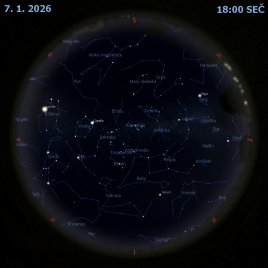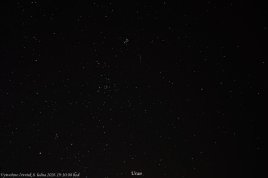Video: Síla desetinásobku
Uznání a copyright videa: Charles & Ray Eames (Eames Office)
Jak se liší vesmír v malých a velkých měřítcích? A na velmi velkých měřítcích? Nejslavnější krátký vědecký film své generace dává výborná srovnání. Tím filmem je Síla desetinásobku (Powers of Ten), původně natočený v 60. letech 20. století, který byl oficiálně zveřejněn na YouTube a je zde. Z deky na pikniku nedaleko Chicaga přes Kupu galaxií v Panně, film každých 10 sekund zvětší strany zobrazovaného čtverce desetinásobně. Devítiminutové video se pak vrací zpátky a každé dvě sekundy strany čtverce desetkrát zmenšuje až končí uvnitř jediného protonu. Sekvence filmu Síla desetinásobku jsou založeny na knize Kosmický pohled (Cosmic View) od Kees Boeke z roku 1957, stejně jako v podobném, ale více animovaném filu Cosmic Zoom, který také vznikl koncem šedesátých let. Měnící se perspektivy jsou natolik úchvatné a poučné, že jednotlivé části byly znovu vytvořeny s pomocí modernějších počítačových technik, včetně prvních několika minut filmu Kontakt. Tvůrci filmu Ray a její manžel Charles Eames, byli známi svým vizionářským duchem a dokonce vynalezli svou vlastní populární židli.
Seznam odkazů v popisu
- Wikipedia: Powers_of_Ten_(film)
- Youtube.com: Powers of Ten™ (1977)
- APOD: 2005-07-24 Pád meteoritů u Chicaga
- APOD: 2022-06-15 V srdci Kupy v Panně
- Quora.com: Powers of Ten™ (1977)
- QuantaMagazine.org: Inside the Proton, the ‘Most Complicated Thing You Could Possibly Imagine’
- EamesOffice.com: A Rough Sketch for a Proposed Film Dealing with the Powers of Ten and the Relative Size of things in the Universe
- Wikipedia: Cosmic_View
- Wikipedia: Kees_Boeke
- Wikipedia: Cosmic_Zoom
- Catit.com: Foto: Kočka s jazýčkem :-)
- FSU.edu: Secret Worlds: The Universe Within
- Htwins.net: The Scale of the Universe 2
- Youtube.com: Contact Intro
- Wikipedia: Charles_and_Ray_Eames
- Wikipedia: Eames_Lounge_Chair_Wood
NASA Official: Phillip Newman Specific rights apply. NASA Web Privacy Policy and Important Notices
A service of: ASD at NASA / GSFC & Michigan Tech. U.
Odkaz na originální APOD


